Is the grading standard of boutique coffee defined by SCAA so strict?
You love coffee, but you may not know or think of it, in fact, coffee beans have a lot of defects, and a variety of defects, all kinds of strange. There are many reasons for defects. Defects may affect our taste experience of coffee at different levels, and may also affect our health. However, many defects that can be clearly seen in raw beans can be quickly invisible once baked. Therefore, the coffee cooked beans I usually see are mostly uniform and consistent in appearance, showing a gorgeous brown color, and their true color and flavor are largely hidden under the modification of milk and a variety of flavor syrup!
Coffee, after all, as a crop, needs to go through a long and arduous process from sowing, planting, harvesting, managing, storing, roasting, preserving and making before it reaches my cup. It is not easy to add color to life. The emergence of large and small defects is very normal, but it is only a matter of how many. And beans who want to become boutique coffee need to go through many hurdles. Everyone needs to know the psychology and the truth. Let's take a look at SCAA (American boutique coffee club) Arabica boutique coffee requirements! After reading this article, you will be able to learn the essence of fine coffee and understand why so many coffee people devote so much energy to improving the quality of coffee and developing high-quality coffee.
[defect subdivision type] (350g raw beans)

According to the SCAA Arabica score (refer to the table above), the defective type of raw coffee beans can be divided into one defect and two defects according to the influence degree of the coffee product. The two major defects have different sub-defects, and each defective bean has a corresponding 1-bit defect. Therefore, quantile defects (full defect) are calculated after calculating the number of defects of each type. Such as: a defect in the position of 1 full black bean, and a defect in the position of 5 worm-eaten beans. (less than 5, 6 is recorded as a first-class defect in a unit). Among the defects, 3 parts of black beans are defective, and 10 microworms are also defective.
Boutique coffee requires enough:
Even one defect in 350g product is not allowed, and the second cannot exceed 5.
In 100g product, no quaker is required.
[water content]
Washed beans: 10% 12%
Sun-dried beans: 10% 13%
[smell of raw beans]
No strange smell.
[raw bean size]
The difference in the contract size is less than 5%.
Note: if multiple defects are found in a coffee bean at the same time, the type of defect that has the greatest impact on the quality of the coffee cup should be selected to score.
The following is a detailed introduction of all kinds of defective beans.
[all black beans and some black beans]

Raw beans that are completely blackened on the inside or outside are opaque black.
Excessive fermentation caused by organic microorganisms.
Cup test performance: fermentation or smelly, dirty, acidity, mildew taste, phenolic flavor.
[whole sour beans, some sour beans]
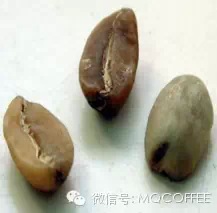
Fermented raw beans with yellowish or reddish brown as a whole.
Fermentation caused by microbial infection in the process of harvest and treatment. The specific reasons may be: harvesting ripe coffee cherries or coffee cherries that fall on the ground; water pollution during processing; or coffee cherries hanging from trees in wet conditions over-ferment.
Cup test performance: according to the degree of fermentation, there may be odor, acidity, fermentation taste.
[fungal infection]
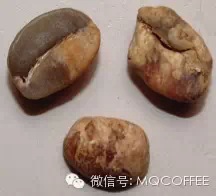
Raw beans with yellow or reddish brown due to mildew.
The temperature and humidity during storage are suitable for mold growth.
Cup test performance: may produce fermentation, mildew taste, dirty taste, phenolic flavor.
[foreign matter]
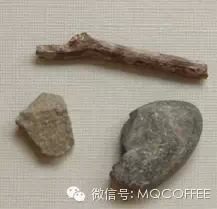
A foreign body other than coffee, such as stones or branches.
It may be produced in any process of raw bean processing.
Cup test performance: let the coffee lose its taste.
[dried coffee cherry pods]
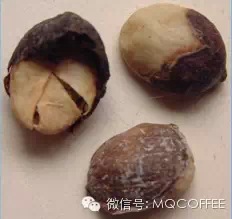
Raw beans partially or completely wrapped in black rind.
The pulp removal process of washing beans is incomplete or the treatment is not complete when the floating matter is removed by entering the water; the treatment of sun-dried beans is not in place in shelling or sorting.
Cup test performance: fermentation, mildew taste, phenolic flavor.
[serious moth-eaten bean, light worm-eaten bean]
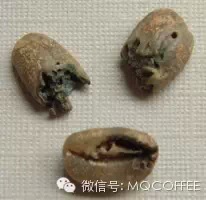
The worm gnawed out less than 3 (light worm-eaten beans) or more than 3 (serious worm-eaten beans) raw beans with a diameter of 0.3~1.5mm holes.
It is mainly affected by coffee worm (berry borer beetle).
Cup test performance: affect the appearance of ripe beans, may bring dirty flavor, Rio flavor, or mildew flavor.
[broken beans]

Broken raw beans or fragments of raw beans.
Raw beans are treated and the machine is not debugged properly in the process of removing pulp.
Cup test performance: soil taste, dirty taste, acidity, fermentation.
[uncooked beans]
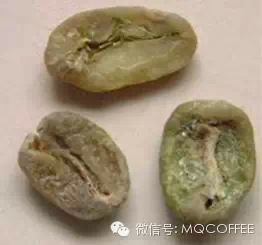
The silver skin firmly adheres to the surface of the raw bean, and the bean body is sunken, small in size, sharp at the end and slightly in the shape of a ship.
Harvest in an immature state.
The cup test shows that the taste of grass, straw and green astringency are the main sources of the astringency of coffee.
[atrophic beans]

Wrinkled, small, malformed raw beans like raisins.
During development, there is insufficient water supply and excessive sunshine.
Cup test performance: grass flavor, straw flavor.
[shell beans]

Thin-skinned shells or malformed raw beans in the shape of ears.
Genes.
Cup test performance: scorched taste.
[floating beans]
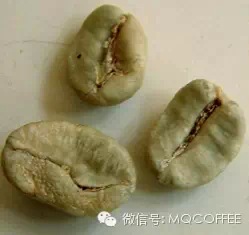
White or faded raw beans float on the water because of their light posture.
Improper storage or drying. Shell beans are left in the corner in the dryer or drying rack to form discolored, low-density beans. Or shell beans are stored in high humidity.
Cup test performance: there may be fermentation, straw flavor, straw flavor, soil flavor, mildew flavor, or it may dilute the flavor without letting the coffee lose its flavor.
[parchment shell beans]
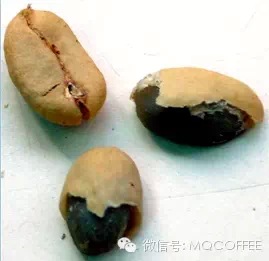
Dried parchment is completely or partially wrapped in raw beans.
Improper machine calibration in the process of processing.
[bean shell]

With dark pieces of dried fruit.
The sun-dried beans were not cleaned in the process, and the pulp removal machine was improperly calibrated.
Cup test performance: can bring dirty taste, soil flavor, mildew flavor, fermentation flavor, phenolic flavor.
[Quick beans]:

It is not fully fried and shallower than other coffee beans.
Well, will you be frightened by these flaws! Then remember to choose boutique coffee!
Organize by: xuwen
Reference: "SCAA Arabica Green Coffee Defect Handbook
The above contents are reproduced from Mingqian Coffee. Thank you here!
Important Notice :
前街咖啡 FrontStreet Coffee has moved to new addredd:
FrontStreet Coffee Address: 315,Donghua East Road,GuangZhou
Tel:020 38364473
- Prev

Coffee Raw Bean sieve grading Table (SCREEN SIZING)
Coffee is produced in more than 50 countries in the world, and different standards of raw bean classification have been derived, of which the most basic common classification method is the Screen Sizing classification method based on the particle size of raw coffee beans. The raw beans to be graded are put into the sieve plate and shaken continuously. Only the raw beans whose particles are larger than the pore diameter are retained, and the rest fall down.
- Next
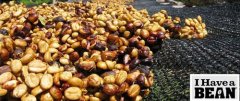
How to grade the coffee beans after honey treatment?
The honey treatment of raw coffee beans is to remove the peel and pulp and retain some or all of the mucous membranes (honey). Today, some Costa Rican growers grade honey-treated coffee beans according to the color of the coffee. There are three levels: yellow, red and black. The change in color results from the length of light during the drying process of coffee. Methods / steps the illumination of raw coffee beans treated with yellow honey
Related
- Guji coffee producing area of Guji, Ethiopia: Humbela, Shakiso, Wulaga
- What is the most expensive variety of Qiloso in BOP multi-variety group?
- How to store the coffee beans bought home?
- Why are Yemeni coffee beans so rare now?
- Ethiopian Sidamo all Red Fruit Sun Sun Santa Vini Coffee beans
- SOE is mostly sour? What does it mean? Is it a single bean? what's the difference between it and Italian blending?
- Is Italian coffee beans suitable for making hand-brewed coffee?
- How to choose coffee beans when making cold coffee? What kind of coffee beans are suitable for making cold coffee?
- Just entered the pit to make coffee, what kind of coffee beans should be chosen?
- Can only Japan buy real Blue Mountain Coffee? What are authentic Jamaican Blue Mountain coffee beans?

